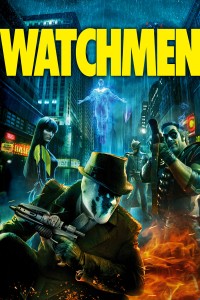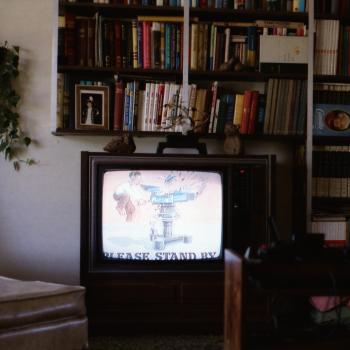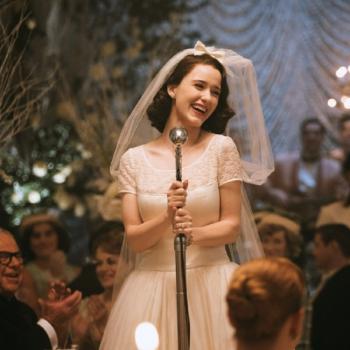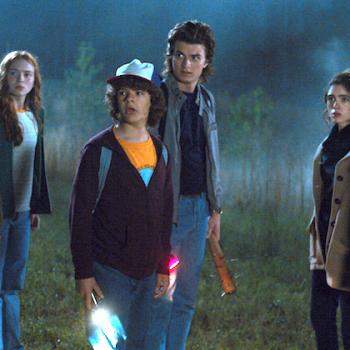 I came late to the DC Comic’s collected Watchmen, the groundbreaking graphic novel by Alan Moore and Dave Gibbons. I backed into it really, watched the movie first with my sons. Though I tell them it’s usually best to read the book first, it seemed okay in this instance to watch the movie because it’s based on comic books. Of course the word comic is not a good description of what we get.
I came late to the DC Comic’s collected Watchmen, the groundbreaking graphic novel by Alan Moore and Dave Gibbons. I backed into it really, watched the movie first with my sons. Though I tell them it’s usually best to read the book first, it seemed okay in this instance to watch the movie because it’s based on comic books. Of course the word comic is not a good description of what we get.
Watchmen is the story of a retired group of masked avengers who are being murdered one by one. The setting is an alternate United States in which Nixon remained president, won reelection, and crushed the North Vietnamese army, and is now changing the laws so that he can remain president indefinitely. Also, Nixon’s finger is itchy to nuke the Russians.
First published in the late eighties, the specter of the mutually assured destruction of the U.S. and the U.S.S.R., and basically the total nuclear annihilation of the world hangs heavy over this dark story. In that sense it is dated, but it is still a great read.
Among the fascinating cast of characters is Dr. Manhattan, who, due to an accident at a research lab, is able to manipulate the structure of the universe on the atomic level. He sees all the way to the smallest particles and all the way out to the ends of the universe. He loses touch with his, and everyone else’s, humanity.
His lover Laurie throws him out because he cannot connect with her emotionally anymore. He looks at everyday objects—her bra for example—as if he can no longer remember what they are for.
He stands in a town called Davidstown in Arizona, which has been decimated by an atomic blast, and he contemplates, “the cold, distant god in whose hands the fate of Davidstown rested.” He wonders, “was he really there? Had he been there once but now departed?” Eventually he comes to view the universe as “a clock without a craftsman.”
In the movie, after discussing molecular physics, and the impossibility of turning oxygen into gold, he says to Laurie, “There are no miracles. Only what can happen does happen.”
So, when Rorschach, the Watchman with a shifting black-and-white inkblot mask, comes and tells Dr. Manhattan that someone is killing them off, Manhattan says, “A live body and a dead body contain the same number of particles. Structurally, there’s no discernible difference.”
I thought of something John Gardner wrote in On Moral Fiction, talking about a body not animated by what he sees as an unnatural force, human consciousness, a state in which “all atoms are equal. In a corpse entropy has won; the brain and the toenails have an equal say.” Manhattan believes this of living humans as well.
Eventually, sick of the chaos that is human existence, Manhattan goes off to Mars to get away from the messiness of people, the chaos of human affairs.
But by the end, in the movie version at least, Dr. Manhattan allows himself to be blamed for the nuking of New York City, and leaves earth for good. All international hostilities end as the world powers now need to ally themselves to meet this new common enemy, Dr. Manhattan.
Why though, if he is so disconnected?
It sounds silly to say it but it is love. Not just love, but love for a specific human being, a particular combination of atoms. He gets jealous when Laurie starts seeing another man, and teleports her to Mars so they can talk, and it is here that he has his epiphany.
When Laurie discovers that her father was the Comedian, an amoral monster, a murderer, and a rapist, she falls apart and says her life is meaningless. And this is where the love scene begins.
“I don’t think your life is meaningless,” he tells her.
Knowing how he views the universe, she asks him how he can say that.
This chapter ends with a quote from C.G. Jung: “As far as we can discern, the sole purpose of human existence is to kindle a light of meaning in the darkness of mere being.”
This is what Manhattan has come to realize. He tells Laurie he was wrong about miracles, “events with odds against so astronomical they’re effectively impossible, like oxygen spontaneously becoming gold.”
“And yet each human coupling,” he tells her, “a thousand million sperm vie for a single egg, multiply those odds by countless generations, against the odds of your ancestors being alive…until your mother loves a man she has every reason to hate, and of that union, of the thousand million children competing for fertilization, it was you, only you, that emerged.”
Then he declares his love for her in his abstract way: “To distill so specific a form from that chaos of improbability, like turning air to gold… that is the crowning unlikelihood.” He tells her that she, standing there before him, is a miracle.
Laurie presses him to the logical conclusion however. She says that if he calls her a miracle then “you could say that about anybody in the world.”
He has to admit it. “Yes,” he says. “Anybody in the world.”
And so everybody in the world is a miracle, not just the people he loves: it is the greatest injustice to consider even a single human expendable, “one more body among foundations,” as Rorschach says.
Dr. Manhattan comes to realize that every human life, “so specific a form,” is a miracle to be cherished, to be guarded.











